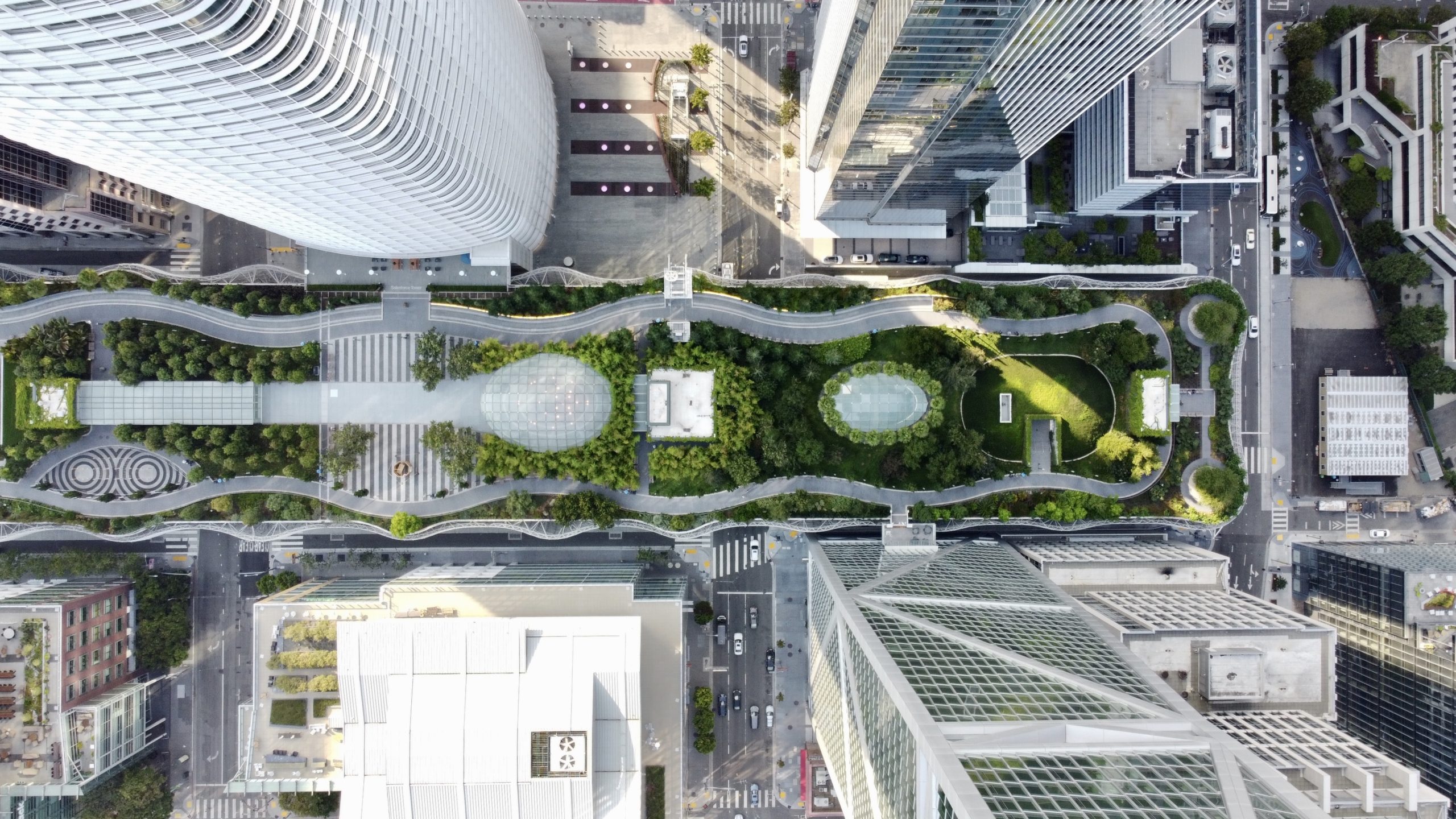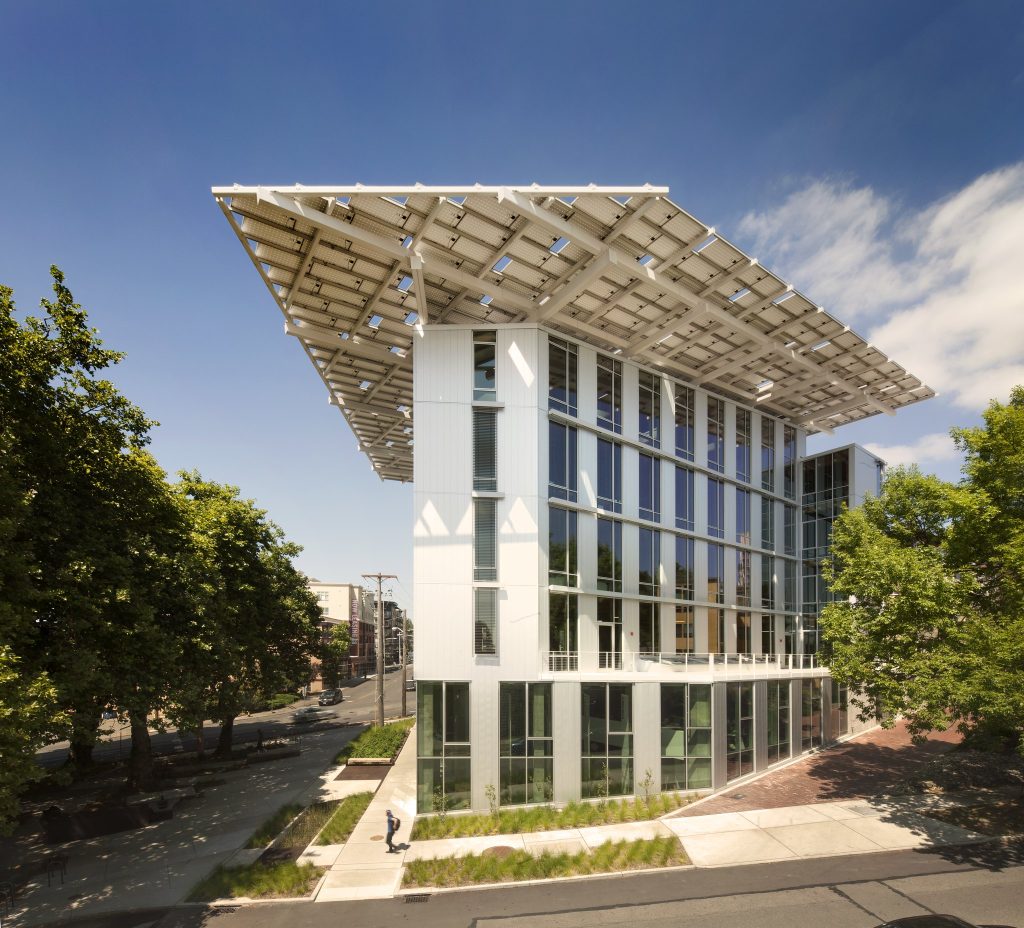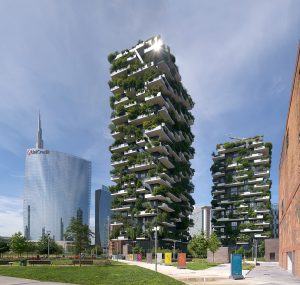What is green building ? A beginner's Guide
By Mz Chaker & EAGC, 2024
Let’s explore what green building is and how eco-friendly design is shaping a sustainable future. Read more now!

As our planet grapples with the escalating impacts of climate change, the way we build our homes, offices, and cities is coming under particular interest. With buildings responsible for nearly 40% of global carbon emissions (UNEP FI), it’s clear that traditional construction methods are no longer sustainable. Enter green building—a revolutionary approach that redefines how we think about the built environment. By blending energy efficiency, sustainable materials, and cutting-edge technologies, green buildings offer a blueprint for a cleaner, healthier, and more resilient future.
But what exactly is green building, and why is it so important for our future? This article will dive deep into the core principles of sustainable architecture and answer the main questions: How do green buildings differ from traditional structures? What innovative technologies are powering the future of construction? And most importantly, how can these buildings contribute to a greener world? Join us on this exploration as we uncover how green building is not just a trend but a necessity for a sustainable future.
1. Green Building: What is it and Why it Matters ?
Core Concepts of Green Building
What is Green Building? Fundamentally, green building is about crafting structures that harmonize with the environment instead of disrupting it. This comprehensive approach involves practices that minimize the ecological footprint of buildings throughout their entire life cycle—from initial design and construction to operation and eventual deconstruction. Key elements include energy efficiency, utilizing renewable resources, and incorporating environmentally friendly materials. However, it goes beyond simply adding solar panels or using recycled products. Green building embodies a holistic philosophy aimed at reducing waste, enhancing efficiency, and fostering a healthier environment for all.
Common misconceptions about green building
Despite the rising popularity of green building, several myths continue to cloud its true benefits. A common misconception is that green buildings are excessively expensive. While initial costs may be higher, the long-term savings in energy, maintenance, and efficiency often outweigh these upfront expenses. Another myth is that green building solely focuses on energy efficiency. In truth, it encompasses a wide range of sustainable practices, including water conservation, waste reduction, and the use of non-toxic materials.
Additionally, some assume green building is only applicable to new construction. However, sustainable methods can be integrated into renovations and retrofits just as effectively. By debunking these myths, we unlock the full potential and value of green building as a key solution for a sustainable future. Indeed, what Green Building is putting forward is more than a trend—it’s a pathway to responsible, future-proof development that everyone can embrace.
Green Building vs. Traditional Building
Moreover, By comparing green and traditional buildings, the differences clearly stand out, reflecting a fundamental shift in how we approach construction and development. Traditional buildings often prioritize cost and speed, frequently at the expense of environmental health. This results in high energy consumption, significant waste, and the use of toxic materials.
In stark contrast, green buildings are rooted in sustainability from the very beginning. These structures integrate energy-efficient systems, prioritize eco-friendly materials, and are designed to foster healthier, more functional spaces. This approach not only lowers the environmental footprint but also leads to lasting economic and social benefits, creating a blueprint for a more sustainable future.
Environmental, Economic, and Social Benefits
So, green building goes beyond benefiting the planet; it’s a catalyst for economic growth and social well-being. Environmentally, it reduces greenhouse gas emissions, conserves water, and minimizes dependence on non-renewable resources. Economically, green buildings offer lower operating costs through energy savings, boost property value, and unlock access to government incentives. Socially, they foster healthier living and working spaces, enhancing well-being and productivity. By embracing sustainable construction practices, we set off a chain reaction of positive impacts that reach every facet of life, from the environment to the economy and our everyday experiences.
2. Key Principles of Green Building design
Energy Efficiency: Cutting Costs and Carbon Footprint
A cornerstone of green building design is maximizing energy efficiency, an essential step in reducing a building’s environmental impact. This principle revolves around minimizing energy use through smart design, advanced technology, and incorporating renewable energy sources like solar panels or wind turbines. Smart insulation, energy-efficient windows, and high-performance HVAC systems work together to reduce the energy needed for heating, cooling, and powering the building.
These measures not only slash operational costs but also shrink the carbon footprint, helping create a more sustainable future. On top of that, energy-efficient buildings often qualify for government incentives, further increasing their financial appeal and long-term viability. By embracing energy efficiency, green buildings demonstrate how smart design contributes to both environmental and economic gains.
Water Conservation: Sustainable Practices for Every Drop

Image
Water, a vital and finite resource, is at the heart of green building design, where conservation is essential. The focus lies in maximizing water efficiency, ensuring every drop is thoughtfully used. Green buildings feature low-flow fixtures, dual-flush toilets, and advanced irrigation systems that cut water consumption without compromising functionality.
Additionally, rainwater harvesting and greywater recycling capture and reuse water for landscaping and non-potable purposes, turning waste into an asset. These strategies not only lower utility costs but also help safeguard our natural water supplies. By prioritizing water conservation, green buildings become an integral part of a more sustainable urban future, proving that responsible resource management can drive progress.
Sustainable Materials: Choosing Eco-Friendly Resources

Image
Selecting the right materials is at the core of sustainable construction. Green building design prioritizes the use of eco-friendly materials that are renewable, non-toxic, and have a low environmental impact. This includes materials that are locally sourced, reducing the carbon footprint associated with transportation.
Additionally, green buildings often use recycled or repurposed materials, giving new life to what would otherwise be waste. The emphasis is on durability and low maintenance, ensuring that these materials contribute to the building’s longevity and sustainability. By choosing sustainable materials, green buildings not only reduce their environmental impact but also promote healthier living environments.
Indoor Environmental Quality: Creating Healthy Spaces
The quality of the indoor environment is a critical component of green building design. By Prioritizing IEQ, indoor spaces are not only energy-efficient, but also conducive to health and well-being. Green buildings achieve this by using non-toxic materials to minimize indoor pollutants, improving air circulation, and optimizing natural light.
Additionally, Incorporating plants and green spaces further enhances air quality while fostering a connection to nature. These combined elements create sustainable and supportive environments for physical and mental health. By focusing on IEQ, green buildings transform indoor spaces into healthier, more productive, and comfortable areas for occupants.
3.Green Building Technologies: Innovations Powering the Future
Renewable Energy Systems
At the heart of green building technologies are renewable energy systems that harness natural resources to power homes and workplaces. Solar panels convert sunlight into clean electricity, turning rooftops into local power sources with increasing efficiency. In urban settings, wind turbines are integrated into smaller spaces, providing sustainable energy solutions even in high-density environments. Geothermal systems, tapping into the earth’s stable underground temperatures, offer a renewable source for heating and cooling, drastically cutting down on fossil fuel use.
These advanced technologies are more than just eco-friendly; they offer significant long-term cost savings. As a result, they have become a fundamental part of what green building is putting forward, driving both economic and environmental benefits. From reducing energy bills to lowering carbon footprints, these sustainable solutions are paving the way for a greener future.
Smart Building Technology
The future of sustainable architecture is taking shape with the rise of intelligent building technology. By embracing the Internet of Things (IoT) and advanced automation, buildings are achieving unprecedented levels of efficiency. Sensors and intelligent meters monitor energy consumption in real-time, optimizing heating, cooling, and lighting systems to minimize waste. Automated controls adjust seamlessly to the occupants’ needs, ensuring comfort while reducing energy consumption.
Beyond efficiency, these technologies significantly enhance the safety and security of buildings, making them more resilient and adaptable to changing conditions. This innovation creates a dynamic, responsive environment that promotes sustainability and livability. As we explore what green building is, it’s clear that technology plays a vital role in shaping a greener, brighter future.
Advanced Insulation and Building Envelope Design
Energy efficiency starts with advanced insulation and innovative building envelope design. These elements are crucial in reducing energy loss and keeping buildings warm in the winter and cool in the summer. High-performance insulation materials, such as spray foam and rigid foam boards, create a barrier that minimizes heat transfer. At the same time, airtight building envelopes prevent leaks, keeping conditioned air inside. Thermal bridging—a common issue in traditional construction—is minimized with advanced design techniques, leading to a significant reduction in energy consumption.
This focus on insulation and envelope integrity is vital for creating buildings that are not only comfortable but also sustainable. It is a key principle in answering, “What is green building?” and understanding its role in shaping energy-efficient spaces that benefit both people and the planet.
Water Recycling and Management Systems
As water scarcity becomes a global challenge, green buildings are turning to innovative water management systems to reduce their environmental impact. Grey water recycling systems capture water from sinks, showers, and laundry, repurposing it for toilets and irrigation. That drastically reduces water waste. Similarly, rainwater harvesting systems collect and store rainwater, providing a sustainable supply for non-potable uses. In addition, advanced plumbing fixtures and leak detection systems ensure efficient water use with minimal waste. By integrating these advanced technologies, green buildings not only conserve water but also contribute to a more sustainable urban future. They demonstrate how innovative design can help address pressing environmental issues, answering the question, “What is green building?” in the context of water conservation.
4. What green building is putting into practice ?
Iconic Green Buildings Around the World
From towering skyscrapers to community centers, iconic green buildings are reshaping skylines and setting new benchmarks in sustainable design. In Seattle, the Bullitt Center—often hailed as the greenest commercial building in the world—proves that eco-friendly structures can be powerful and practical. It operates on net-zero energy, collects rainwater, and even uses composting toilets.
Meanwhile, in Singapore, the PARKROYAL on Pickering Hotel merges stunning vertical gardens with advanced sustainable technologies, offering a lush, green sanctuary amidst the urban jungle. Over in Milan, the Bosco Verticale towers rise with over 20,000 plants. These living walls reduce the city’s heat and naturally purify the air.
These bold projects show that green buildings are achievable but also revolutionary. They push the limits of modern architecture while inspiring others to embrace sustainable solutions, leading the way for a greener future. Each project embodies the core answer to What green building is, highlighting innovation, sustainability, and environmental harmony.

The Bullitt Center in Seattle by @Brad Kahn on flickr

The PARKROYAL on Pickering by @Erwin Soo on flickr

The Bosco Verticale in Milan@ by Thomas Ledl on Wikipedia
Community Green Building Projects
Sustainability isn’t just for architects and developers—it’s a movement embraced by entire communities. Around the world, community-driven green building projects are flourishing, fueled by a collective vision for sustainable living. In London, the BedZED (Beddington Zero Energy Development) eco-village leads the way, using renewable energy, recycling water, and encouraging sustainable transport.
In Portland, Oregon, the Cully Green project transforms a former brownfield site into a lively, eco-friendly neighborhood with energy-efficient homes and shared green spaces. These projects prove that when communities unite, they can create sustainable, innovative spaces that benefit both people and the planet.
Residential Green Building
Residential green building is not just a passing trend; it is a movement reshaping the way we live. From compact, eco-friendly tiny homes to sprawling luxury estates designed with sustainability in mind, these homes are becoming more widespread. The passive house standard, which can reduce energy use for heating and cooling by up to 90%, is gaining traction across the globe.
Take the Desert Rain House in Oregon, for example. This net-positive energy home generates more power than it consumes while also collecting water. It is a perfect blend of sustainable living and modern comfort, proving that eco-conscious design doesn’t require sacrificing style or convenience.
Green buildings like these show how adaptable eco-friendly living spaces can be. Whether you’re seeking a minimalist lifestyle or a more lavish experience, these homes prove that anyone can live in harmony with the environment. What green building is leading is that it’s all about creating spaces that benefit both people and the planet.
Commercial and Industrial Green Buildings
The corporate world is quickly embracing green construction as more than just a marketing tool—it is now a key business strategy. Companies are adopting green buildings to reduce energy costs, improve employee health, and meet the increasing market demand for sustainability.
Take The Edge in Amsterdam, often called the world’s most sustainable office building. Indeed, it leverages smart technology to optimize energy use and foster a healthier workplace. In the same way, Tesla leads the way with its Gigafactories in the industrial sector. So, they integrate renewable energy sources and sustainable materials to reduce their environmental footprint.
These examples highlight how businesses are not just adopting green construction practices but actively pioneering the creation of workspaces that benefit people, increase profits, and protect the planet. Indeed, these examples illustrate how businesses are adopting green construction practices. Even more, they show what green building is leading for designing sustainable workspaces that are good for people, profits, and the planet.
5. The Future of Green Building: What is the trend ?
Emerging Technologies in Green Building : What is on the Horizon for Sustainable Construction
The future of green building is full of promise as emerging technologies continue to reshape the industry. For instance, innovations like 3D printing and prefabrication speed up construction while making it more cost-effective and eco-friendly. Likewise, advanced materials such as self-healing concrete and transparent solar panels are pushing the limits of modern architecture.
In addition, artificial intelligence (AI) is changing building management, allowing for real-time energy optimization and predictive maintenance. These breakthrough technologies help to elevate sustainable construction to new heights, making it more efficient, accessible, and impactful. As we explore what green building is, these advancements will play a crucial role in shaping the future of construction.
How Governments are Shaping the Future of Green Building
As demand for green buildings rises, governments worldwide are shaping the future through policies and regulations. Building codes are evolving to enforce higher energy efficiency standards, while incentives promote renewable energy systems. In Europe, the EU Green Deal sets a bold goal of carbon-neutral buildings by 2050, serving as an example for other regions.
Similarly, programs like LEED certification in the United States push sustainable practices nationwide. These regulations drive the adoption of green building techniques and make them more accessible and standardized. As governments increasingly prioritize sustainability, policy will play a key role in guiding the construction industry toward a greener future. That is what green buildings are plotting to lay the foundation for the eco-friendly cities of tomorrow.
Green Building in Developing Countries
As green building gains momentum in developed nations, attention is shifting toward expanding sustainable practices in developing countries. These regions present unique challenges and opportunities for green construction while they cope with rapid urbanization and population growth. For instance, green building emerges as a solution to housing shortages in countries like India and Brazil. It also boosts energy efficiency and enhances resilience to climate change.
Moreover, projects like the Kachumbala Maternity Unit in Uganda show how eco-friendly construction can improve quality of life. Thus, solar power and sustainable materials reduce environmental impact. As these markets grow, adopting what green building is putting into practice will be essential for promoting sustainable, inclusive development. Indeed, this is the path to a resilient, eco-conscious future.
The Vision for 2050
Green building is more than a construction trend; it’s a pivotal step toward a sustainable future. By integrating eco-friendly practices, green buildings significantly reduce environmental impact while promoting economic and social benefits. From energy efficiency and water conservation to innovative technologies, the principles of green building design are reshaping how we construct our spaces. Real-world examples highlight the practical application and success of these concepts. That proves that green building is viable and essential.
As we move forward, your role in green building becomes crucial. Whether you are a homeowner, developer, or simply environmentally conscious, embracing these practices contributes to a healthier planet. The journey ahead is one of continuous learning and action. Begin today by exploring how you can incorporate green building principles into your projects and take a role in shaping a sustainable future. The time to act is now—be part of the change.
In conclusion, Green building is more than a construction trend; it’s a pivotal step toward a sustainable future. By integrating eco-friendly practices, green buildings significantly reduce environmental impact while promoting economic and social benefits. From energy efficiency and water conservation to innovative technologies, the principles of green building design are reshaping how we construct our spaces. Real-world examples highlight the practical application and success of these concepts, proving that green building is both viable and essential.
As we move forward, your role in green building becomes crucial. Whether you’re a homeowner, developer, or simply environmentally conscious, embracing these practices contributes to a healthier planet. The journey ahead is one of continuous learning and action. Begin today by exploring how you can incorporate green building principles into your projects, and take an active role in shaping a sustainable future. The time to act is now—be part of the change.






